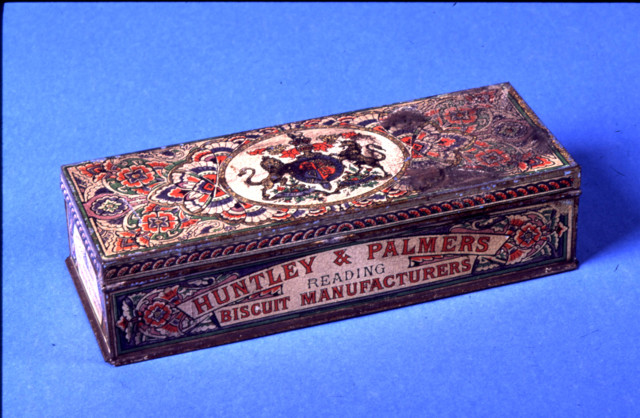Initially, Huntley & Palmers' tin designs were printed directly onto the tin using a lithographic stone and usually involved only two colours. In the 1860s transfer printing developed whereby the image would appear on paper. This would be soaked and pressed onto the tin and the backing paper would be wiped off. The same method is still used today for children's stick-on tattoos.
Decorative tins
From 1868 Joseph Huntley also began to design and produce small, highly decorative gift tins. The Ben George tin (below) was decorated by the transfer process, patented by Benjamin George of London, hence the name of the tin.

This 'Ben George’ tin of 1868 is the earliest example of a printed biscuit tin. A layer of oil was applied to the tin, before a transfer paper with the design on it was placed on top. The backing paper was removed, leaving the design on the tin (1992.2.1)
Offset lithography
The tin-box making business was renamed Huntley, Boorne & Stevens in 1872 and in 1877 they acquired exclusive rights from Bryant & May (the match company) to the new 'offset lithography' process for printing on metal. This new technique allowed the manufacture of more complex shapes and coloured tins.

From 1882 until 1922, Britain controlled the colonial administration of Egypt. This tin, produced in 1890, reflects the influence of the British Empire on biscuit tin designs. (REDMG : 1992.2.48)
The changing shape of tins
The early tins to be produced were in the shape of rectangular or square boxes and were decorated with simple designs or images of birds, people or places. However by the 1890s tins shaped as actual objects began to appear. Between 1900 and 1924 over 650,000 book-shaped tins were issued by the company in ten different variations.

This 'Waverley' tin was the third in a series simulating bound books. One of the most popular style of tins, over 650,000 were made, in ten different variations, until 1924. (REDMG : 1969.188.1)
Whilst the early biscuit tins had featured the biscuit manufacturers name on the design, it became increasingly unfashionable to use such blatant advertising in the Victorian Era. From the 1880s, when the firms name was only inscribed on the base of the tin, the tins became acceptable objects to use as ornaments or as storage in the home.
In the next section, learn about Huntley & Palmers' tins from 1860 to 1915.





